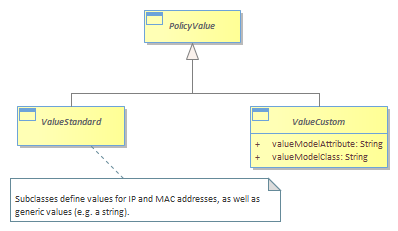Figure 1P-17 - Simple PolicyValue

|
Project:
|

Figure 1P-17 - Simple PolicyValue : Class diagram
The PolicyValue class is an abstract base class for modeling different types of values that occur in a PolicyStatement. The PolicyValue specifies an attribute that should either be set or cleared (if used in a PolicyAction) or matched or compared in some way to a value of the PolicyVariable in a PolicyCondition. It is shown in Figure below.<br/>Note the similarity in the basic design approach between PolicyVariables and PolicyValues.<br/>The ValueStandard class is an abstract base class for defining a set of standardized PolicyValues. This set of PolicyValues will be added to over time, and represents a set of common values that are useful in a variety of applications. The subclasses of ValueStandard are a set of classes that define the semantics of commonly occurring variables that occur in applications. There are currently six subclasses of the ValueStandard object defined in the model.<br/>The ValueCustom class is an abstract base class that provides two basic attributes to define custom value objects that can be used in an application-specific fashion. These two attributes are called valueModelAttribute and valueModelClass. The valueModelAttribute is a string attribute that defines the name of the attribute within the class specified in the valueModelClass attribute that is to be evaluated or set as a PolicyValue. The valueModelClass is a string attribute that defines the class name whose attribute is to be evaluated or set as a PolicyValue. This combination enables new custom subclasses of ValueCustom to be defined that specify the class and attribute that they are modeling. <br/>Thus, the combination of valueModelClass and valueModelAttribute enable an application to define a new class that contains an attribute to be used as a PolicyValue. This provides important extensibility, and enables an application to define its own set of classes and attributes to extend the Framework.<br/>
|


